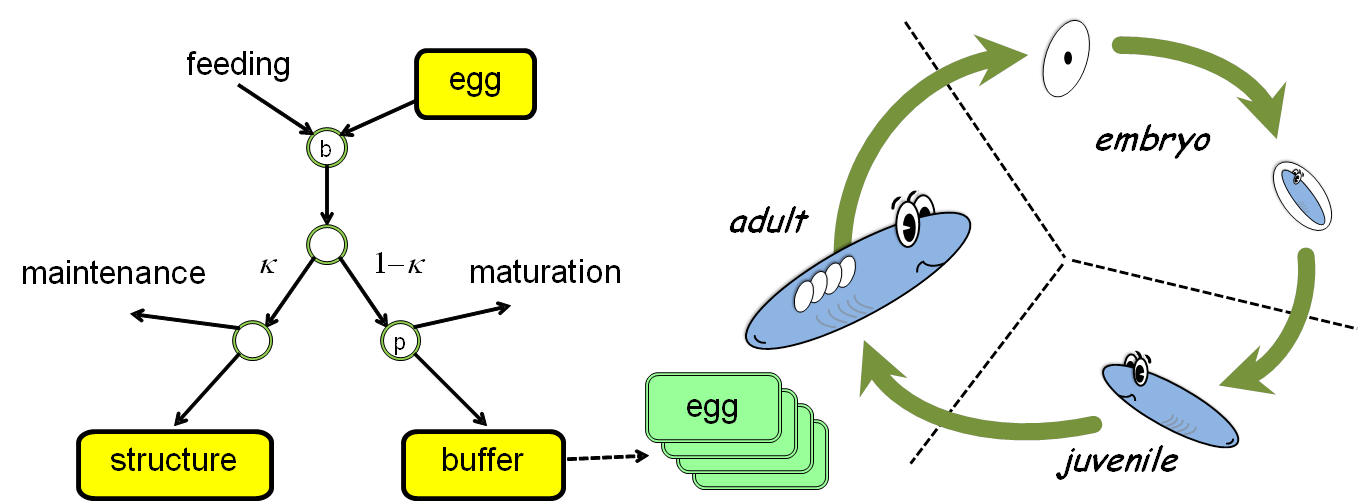
DEBtox information
Making sense of ecotoxicity test results

Main menu
Submenu
| |
||
 DEBtox information Making sense of ecotoxicity test results |

|
|
|---|---|---|
Main menu |
Submenu |
|
DEBtox information |
DEBtox information |
|
What does DEBkiss stand for?DEBkiss is the application of the KISS principle ("keep it simple, stupid") to Dynamic Energy Budget (DEB) theory. DEB theory is very elegant and powerful, but for many applications, simpler approaches are more useful. Specifically, working with rather small invertebrate animals, it turns out to be almost impossible to estimate the parameters governing the reserve dynamics: in most cases, a vanishingly small reserve compartment also explains the data well. Preparing for the 2012 TKTD Summercourse, I came up with the idea of working out a formal reserve-less DEB model (with explicit mass balance) for the course participants to play with. The resulting model is easy to explain but also turned out to be surprisingly powerful in practice, explaining life-history patterns in (small, invertebrate) animals and stressor effects. DEBkiss therefore has become much more than 'just' a teaching tool. DEBkiss can be viewed as a simplification of the standard DEB animal model (it almost qualifies as a special case). However, it can also be viewed as a re-appreciation of the 1984 Kooijman-Metz model, and extending it into a more formal framework. It clearly rests heavily on these two pillars.  How can an animal work without reserve?First, you should realise that 'reserve' does not equal 'storage' or 'lipids'. In DEB theory, biomass is split up into structure and reserve compartments with different dynamics to capture certain observed patterns in organisms (e.g., that body composition sometimes depends on food density). In DEBkiss, biomass is treated as a single compartment, with the dynamics of 'structure', in a DEB sense (e.g., it requires energy to maintain). In DEB theory, the relative size of the reserve compartment is expected to scale between species with maximum body size, so the DEBkiss simplification is likely most applicable to small (invertebrate) animals. Quite a number of small species build up large lipid stores, but these stores are best viewed as a reproduction buffer instead of a reserve in the DEB sense (which implies a different dynamics). Interestingly, the list of publications also includes successful case studies for rather large species, so it is not a priori necessary to discard the model for those. Reserve plays a central role in DEB theory, so removing it is not a small step. There are two main problems that need to be addressed: what does the animal do when food is insufficient to pay maintenance (starvation), and how does the embryo develop? Firstly, it is good to realise that DEBkiss is not equipped to track very short-term changes in food supply (such as the arrival of individual food particles or single meals). The organism will have buffering systems in place (such as the gut system) to smooth out rapid changes in food supply without the need to drastically alter resource allocation. In case of rapid changes in food availability, the first step will thus be to use a time-weighted average for the effective food situation that the organism will experience. True starvation is dealt with in DEBkiss in three subsequent steps: first, the animal uses the reproduction buffer to pay maintenance, then it extracts energy from the flux to maturation/reproduction, and finally it will shrink (burn structure) with a certain efficiency. Regarding embryonic development, a fresh egg represents a tiny amount structural biomass with a large buffer of resources provided by the mother. DEB theory treats this buffer as part of the 'reserve' that is mobilised following the same rules as for the feeding stages, and birth takes place at a certain level of 'maturity'. In DEBkiss, the egg buffer is treated as a sac of 'food' that the embryo assimilates at a rate proportional to its surface area (similar to the situation of feeding) until the buffer is empty (which marks 'birth'). Are you saying that reserve does not exist?No, that is not quite what I am implying. Animals do not have to feed continuously to maintain their structure and their growth and reproductive output, so there must be some form of buffering. I am questioning, however, whether an explicit dynamic reserve compartment is needed in every energy-budget model and for all purposes (and I also have doubts about the specific dynamics used in DEB theory). The experience with DEBkiss shows that excluding the reserve compartment is an acceptable, and extremely practical, simplification for many situations (see list of publications). I hope that the experience with DEBkiss will lead to a broader discussion on the role of 'reserve', and the best way to represent it, in energy-budget models. I think this is an area where more fundamental research (theoretical and especially experimental) is needed. Nevertheless, it is by now very clear that reserve-less, or perhaps more accurately implicit-reserve, models are useful for a range of practical purposes. What are (dis)advantages of DEBkiss compared to standard DEB?A disadvantage is that DEBkiss is a clear departure from the 'standard DEB model', and focuses on animals only, which distracts from the universality of DEB theory. Furthermore, the model parameters of both approaches cannot be directly compared, so DEBkiss analyses cannot easily contribute to the development of the theory or to the add-my-pet library. However, advantages are a model that is easier to explain, requires less parameters, has less state variables, is easier to implement (no reserve dynamics, and no need for an awkward calculation of egg costs), is easier to expand (e.g., to include more elaborate TK models), and is more straightforward to calibrate to data and interpret the results (a more direct link between state variables and observable properties). Which model to use depends on the question, but I am convinced that there are plenty of cases where sacrificing uniformity for simplicity makes a lot of sense. Environmental risk assessment is a typical area where ease-of-use and transparency outweighs the need for building overarching theories. The recent publication of Romoli et al (see below) shows that DEBkiss-based and standard-DEB-based TKTD models will produce very similar fits to data and very similar model predictions for risk assessment purposes. Where is DEBkiss published?A paper presenting DEBkiss has been published in 2013 in the Journal of Theoretical Biology. That paper has been turned into a dedicated e-book that can be downloaded from Leanpub (see support pager over here). A publication list with all DEBkiss publications can be found here. More recently, in 2020, a model version in easy-to-understand compound parameters was published. This version was presented as an update of the classical DEBtox model. Key references in the open literature
Is there software to perform DEBkiss calculations?There are several BYOM packages for DEBkiss/DEBtox. However, the equations are simple enough to program in the software of your choice (even in a spreadsheet). Download the handout for the DEBkiss poster. |
|